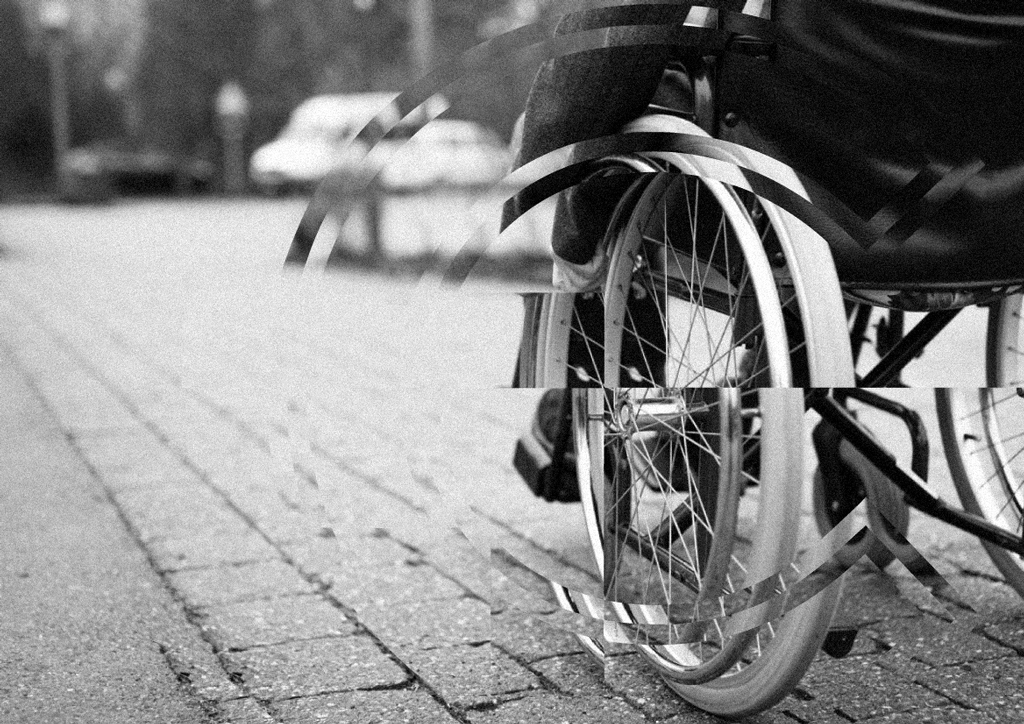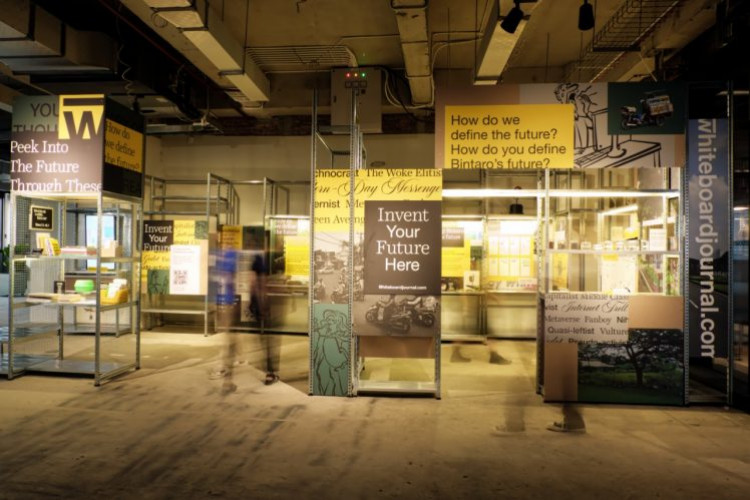
“Have you ever got honked by a car?”
“Oh, a lot.”
The man I met propelled his wheelchair along the asphalted road. Every once in while, a car went past him in a close proximity. I didn’t get to witness the honking, maybe because it wasn’t a busy road, just a two-way road at a residential area in the southern area of Jakarta.
Meanwhile, I walked on a pedestrian way beside the road. The pathway is slightly elevated from the road level with cracked kerb as the edge and has roughly 1.5 metres of width. The cemented surface has crevices and loaded with holes, making it awfully uneven and challenging to walk on – note that “bumpy” would be an understatement. Every few metres, a telephone pole or a tree stood in the middle of the pathway, dividing it into 2 narrow lanes.
This simple experience of mine prompts a question in my head. How hard for those in the wheelchair to move around in the city?
As probably many have known, some paths in Jakarta, especially the pedestrian ways, are in poor condition. It is a widely known fact that pedestrian ways in Jakarta are severely treated, starting from the domination of street hawkers, or becoming a temporary alternate usage for motorcycles to escape traffic congestions, or simply no pedestrian way at all. Ask a Jakarta’s citizen about doing a long walk within the city and the answer will almost certain be unenthusiastic.
Supporting this concerning fact, a Jakarta-based movement that advocates the right of pedestrians; Koalisi Pejalan Kaki, has conducted an observation which concludes that only 20% of the pedestrian ways in Jakarta are deemed suitable for pedestrians and only 6% of them are up to standard for the disabled. Some examples of the decent pedestrian ways are presumably in SCBD and along Jl. MH Thamrin which are considered spacious, clean, and well-tended – a contrasting condition compared to most pathways in other area in Jakarta.
Coming across some wheelchair users, I had hoped to hear some despising comments towards the pedestrian ways in Jakarta. After all, one wheelchair needs bigger space as opposed to an able-bodied man.* Moreover, wheelchair users have limitations regarding the path they could tread on. Similar to that of a car, the paths need to be level and the surface should be smooth enough for the wheels to rotate. Instead of steps of stairs to connect extreme height differences, ramp with the maximum angle of 7 per cent is advisable for them. Nevertheless, the fact that many pedestrian ways in Jakarta are often beaten up and narrow, even close to non-existent, could not fit the picture.
The man I met, who has been bounded to a wheelchair due to an accident, recounted his fear of going outside the house in his early time as a wheelchair user. “Aside from the paranoia towards people’s stare, there was this fear of not being able to overcome the obstacle I might encounter on the street,” he said.
He prefers to stroll down the road for vehicles since the surface is generally wheel-friendly. At times when he propelled along the pedestrian way and encountered holes or impassable barriers alike, he would get down to the road and come back to the pedestrian way once the path was passable. When the pedestrian way is far higher than the road, he would need to turn back and search for a ramp that could get him down the road, to then continue his walk on the road all over again.
As when the content was as negative as I had expected, another view turned the wheel. “It has been a better city nowadays for wheelchair users,” opined another man, who is also a wheelchair user. I remember I had mused sceptically in response. He then mentioned Taman Impian Jaya Ancol as a place he could now enjoy, compared to some years ago. Indeed, since 2012, the 552-hectare area has finished the construction of an 8-meter-wide promenade that spans along the seashore. The path is covered in polished stone tiles and every few meters, there is a ramp that connects the elevated promenade to the vehicles road. The spacious and smooth pathway is certainly an apt need for those in wheelchairs.
Yet, going to the northern edge of Jakarta from other Jakarta’s administrative cities, for example, is another topic altogether. Aside from riding a self-owned car, ordering online drivers has been a common option for people who have a bit of extra cash. An economical option would be by using public transportations. Determined to provide an accessible public transportation for disabled, Jakarta’s government has launched a small number of TransJakarta Cares cars back in 2016. The cars are available to be ordered for free and will take the disabled citizens to the nearest TransJakarta’s shelter. They will continue the journey with TransJakarta and will be picked up by another TransJakarta Cares car at the end shelter to be dropped right at the destination.
The programme didn’t manage to convince me. Aside from some complaints written in several news portals regarding the limited number of cars and how some people managed to ride the car to their destination without the need to take the TransJakarta, the programme doesn’t solve the issue of riding the bus itself. Some TransJakarta shelters are adjoined with a crossing bridge, along with stairs as its only access, while some have really steep ramps. Also, the gap between the shelter and the bus is often wide enough for a person to actually dive in between.
But I almost overlook the fact that the city itself could ease the problem. By ‘the city,’ it means through its citizens. Based on data of World Population Review, Jakarta is a metropolitan city that never fails to amaze people with its extreme density, having an estimation of approximately 10.8 million populations in 2018 and keep on growing. Thus, naturally, there are many helping hands for wheelchair users to depend on whenever some assistance is needed to tackle down the hostile paths of Jakarta. Then, instead of berating the current condition, the important question would be: what can we all do to make the city amiable for those on the wheelchairs?
Many wheelchair users are aware that they must act independently so as to avoid the prejudice of inducing self-pity from strangers**, which becomes a factor of reluctance in asking for help. They seldom go around without accompany. On the other side, most people are possibly not sure on the assistance they could offer and choose to stay quiet, resulting in the act of a seemingly ignorant manner and even avoidance towards wheelchair users – or they basically don’t care, it’s a different matter.
However, the help that the wheelchair users need in public places are not something over-demanding. In an occasion, what they need is probably as simple as a push to get away from a cranny on the street, or half-lifting the wheelchair to overcome the kerbs on pedestrian ways. In TransJakarta bus, they will need the help to lift the wheelchair to get in or out the bus, which are usually done by the officers. Even holding an opened door, even if the person is actually able to do it, is as normal as holding the door for a stranger behind us and will be met with gratitude. Able-bodied people could also ask regarding the help the wheelchair users particularly need, as natural as tending another person who is in a pinch.
In the end, this is not a writing to complain or chastise. It’s a self-reminding note as well as a piece of thought that wishes Jakarta to be a better place for wheelchair users. Perhaps the city itself, with its many infrastructures and facilities, still need a long winding way to go until it becomes barrier-free, or even better, universally-designed*** city. But for now, a little push from our own citizens could act as a catalyst towards a city that accommodates not only engine-wheels but also wheelchairs.
* A basic-modelled wheelchair has a standard width of approximately 0.8 meter and needs at least 1.3 meter to manoeuvre around. Meanwhile, one man is measured to fit through a 0.7 meter-wide space, and even to a narrower width by going sideways. (Ernest and Peter Neufert, Architect’s Data 3rd Edition, Oxford:Blackwell Science, 2003)
** From a paper titled “Managing Emotions in Public: The Case of Wheelchair Users” by Spencer E. Cahill and Robin Eggleston, published in 1994. The particular part is also quoting from Candance Clark “Sympathy Biography and Sympathy Margin” published in 1987.
*** The term “universal design” creates products and environment that benefits the greatest extent of users, with or without disability, without any adaptation or specialized design. It is different from “accessible design”, which promotes accessibility that is specially targeted for people with disabilities. (The City of Calgary, Universal Design Handbook, 2010)
“The Paths for Wheelchairs” ditulis oleh:
Ranti Ekaputri
An architecture graduate from Institut Teknologi Bandung with a love for dance and literature. Her writings have appeared in ARCHINESIA Bookgazine. She also writes short fiction on her blog.











